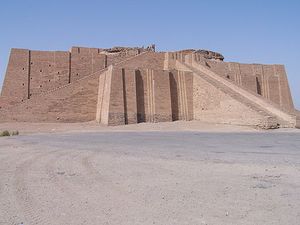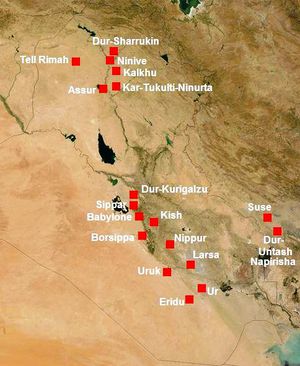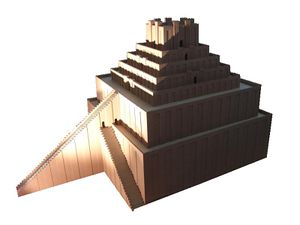What Was the Importance of Ziggurats in Ancient Mesopotamia
The people of ancient Mesopotamia practiced a religion that modern scholars are only just now beginning to understand and the physical focal point of their religion were the monumental, triangular structures known as ziggurats. Today, many people like to compare ziggurats – which is derived from the ancient Akkadian word for the structures, ziggurratu – with their counterparts the pyramids in Egypt. Although both pyramids and ziggurats were constructed during the same time period, they served different functions and were built using different methods and from different materials. Ziggurats were also built over a much longer period than Egyptian pyramids and most importantly, ziggurats were built by a plethora of different people who inhabited ancient Mesopotamia. Mesopotamia, unlike Egypt, was full of disparate and at times warring ethnic groups, but they all followed a similar religion and built ziggurats to appease their gods and as signs of temporal power.
The fact that ziggurat construction took place over such a long period – from the third millennium until the sixth century BC[1] and was done by so many different groups of people is an indicator of the importance of these colossal structures. An examination of the various dynasties that came to rule Mesopotamia shows that ziggurats were important for a number of reasons: they served as a way for the people to connect to their most important gods, they provided a focal point for the secular community, and they also acted as a visible and tangible sign of a king’s power. Any king worth his salt in ancient Mesopotamia had to build a ziggurat that could be seen for miles around, which would ultimately serve to immortalize him for posterity.
The Purpose and Construction of Ziggurats
The development of ziggurats, like most monumental building in the ancient world, was a long process that took hundreds of years to reach its maturity. Unfortunately, there is no known extant text that explains precisely what ziggurats were intended to symbolize, but based on references to the structures in Sumerian and Akkadian language texts, modern scholars have determined that the ancient Mesopotamians believed they were the earthly homes of their many deities. [2]
The Sumerians were the first ethnic group to bring civilization to Mesopotamia and they were also the first people to build ziggurats in the southern portion of that land, which is generally known as Sumer. It was during what is known as the Uruk Period (ca. 3500-2900 BC) – named for the city where civilization first began in Mesopotamia – when temples began to be built that can be considered “archaic” or proto-ziggurats. Essentially, the first of these ziggurats were comprised of a simple tower built on top of a platform. One of the first proto-ziggurats was known as the “White Temple,” which towered forty feet above the city of Uruk. [3]
Later, true ziggurats would dwarf these early ones in size, but the meaning, style, and construction methods used to make them were established during this early period by the Sumerians. It was also during this early period when the secular, along with the religious importance of ziggurats was first solidified. Modern archaeological excavations in Mesopotamia have determined that ziggurats were often the first buildings constructed in a settlement and that they in fact provided much of the impetus for early urban development in Mesopotamia. [4] As Mesopotamian cities grew in size, ziggurats were also at the center of the growth.
As mentioned above, a ziggurat was believed to be the earthly home of the god or goddess for whom it was dedicated. The concept was certainly not unique among pre-modern religions, but what ziggurats were meant to symbolize was. The first ziggurats were simple structures; most were built on top of hills or large mounds, which were believed to symbolize a mountain with the top room being the actual abode of the god or goddess. [5] As history progressed and more resources and better building techniques became available, ziggurats became much larger and more intricate. The higher a ziggurat went, the closer one was to god was the belief. A king would take special pride in a ziggurat built during his reign and would often name the monuments. For instance, the Ziggurat of Enlil at Nippur was known as the “House of the Mountain, Mountain of the Storm, and Bond Between Heaven and Earth.” [6]
Besides functioning as the earthly home of a particular deity, ziggurats were part of larger temple complexes where young men would study in scribal schools and some of the world’s first astronomers observed the celestial bodies. [7] Under the shade of the towering ziggurats, Mesopotamian scholars developed advanced math, even formulating the concept of fractions, although all of their math and science was practical and not theoretical as it is today. [8]
Mesopotamians took the knowledge they learned at ziggurat temple complexes to create bigger and more intricate ziggurats. Although ziggurats were truly impressive monuments to behold, they have for the most part not stood the test of time. Unlike the pyramids, which were made of stone, ziggurats were made primarily of mud brick and clay with some stone. [9] Unfortunately, despite being constructed with sound methods and mathematical precision, the core material of clay and mud brick led to the demise of nearly every ziggurat in Mesopotamia. Today, only the ziggurats that have been preserved by modern antiquities services have survived and oftentimes only the parts made of stone. With that said, the ephemeral nature of ziggurat building material was not enough to stop numerous kings from several dynasties from constructing ziggurats and improving on the techniques of their predecessors.
A Chronology of Some Notable Ziggurats
As noted above, the earliest ziggurats were built by the Sumerians in the southern region of Mesopotamia in the third millennium BC. At that time, Mesopotamia was essentially divided into several independent and often competing city-states until the Third Dynasty of Ur – named for the home city of the dynasty – was established by Ur-Nammu (ruled ca. 2112-2095 BC). [10] Ur-Nammu unified the region through force, but then set about to legitimize his rule, and that of his dynasty, through a variety of measures, one of which was the construction of the Ziggurat of Ur. The ziggurat was dedicated to the moon-god and stood at the center of a massive temple complex that dominated the city of Ur. [11] The size of the Ziggurat of Ur was so much more massive than any of its predecessors – its base measures 190 by 130 feet and although only two levels remain today, scholars believe that there was once a third level. [12] When the Third Dynasty of Ur collapsed, the Sumerians disappeared as a people by assimilating with their other Mesopotamian neighbors, but the importance of ziggurat building continued with other ethnic groups that came to rule Mesopotamia.
After the decline of the Sumerians, the cultural focus of Mesopotamia shifted northward to the region around the city of Babylon, which was known as Babylonia. It was in and around Babylon where kings of the Amorite and Kassite ethnic groups built their ziggurats to honor their gods and to express their political legitimacy to the people. One of the more impressive ziggurats was built by a Kassite king named Kurigalzu I (reigned sometime in the early fourteenth century BC) in a newly founded city. The name of the city was Dur-Kurigalzu (“Kurigalzuville”), which was located in the northern area of Babylonia. The ziggurat formed the center piece in a large palace and temple complex, much like its predecessors in southern Mesopotamia. [13] The construction of the city of Dur-Kurigalzu on virgin soil and the accompanying ziggurat were meant to appease the Babylonian god Marduk, no doubt, but also to legitimize the reign of the enigmatic and poorly documented Kurigalzu I. As time went on in ancient Mesopotamia, the political importance of ziggurats continued to increase – kings continued to build bigger and more impressive ziggurats as testaments to their greatness.
Among the numerous different peoples to engage in ziggurat building in ancient Mesopotamia, the Elamites may have been the most interesting. Located just to the east of Mesopotamia proper, the region of Elam nonetheless became integrated into the Mesopotamian system at an early date. [14] By the fifteenth century BC, the Elamites were major players in the power struggle in the region and had established a dynasty that was based around the city Susa. The Elamite kings followed the precedent established by the Sumerian and Babylonian kings by building ziggurats for their primary gods and as a way to legitimize their dynasties. In a move similar to that of Kurigalzu I, the Elamite king Untash-Napirisha (ruled ca. 1340-1300 BC) founded a new city named after him – Al-Untash-Napirisha – with a large ziggurat being the center piece. The ziggurat was dedicated to two gods: Napirisha, the primary god of the Elamites and Inshushinak, the patron god of Susa. Millions of mud clay bricks were stacked in several rows to make the Ziggurat of Al-Untash-Napirisha, which not only made it one of the largest, but also one of the best preserved ziggurats in history. [15]
The first millennium BC saw the political and cultural energy of Mesopotamia migrate once more to the north, this time to the region of Assyria on and around the Tigris River. When the Assyrians were not busy conquering the rest of the Near East, they were building new cities such as Nineveh, Assur, and Nimrud. Most of the major Assyrian cities had ziggurats, which were dedicated to their primary deities – Assur and Ishtar – but also served as a visible reminder of Assyrian supremacy in the region. Assurnasirpal II (ruled 853-859 BC) chose to build his ziggurat in the city of Nimrud[16], but unfortunately, like with most ziggurats and all Assyrian ziggurats, nothing remains. The fourth century BC Greek general and historian, Xenophon, wrote what was probably the last account of the Ziggurat of Nimrud when he and his contingent of Greek mercenaries passed by it in 399 BC. Xenophon noted: “Near the city there was a pyramid of stone, a hundred feet broad, and two hundred feet high.” [17] It is worth pointing out that Xenophon only viewed the remains of the ziggurat, which means that it was probably much taller when it was operational.
Assurnasirpal II’s Assyrian successors continued the tradition of ziggurat building, but none put forth efforts as impressive as Sargon II’s (reigned 721-705 BC). Like Kurigalzu I in Babylon and Untash-Napirisha in Elam, Sargon II commissioned a new city to be built, Dur-Sharrukin (“Sargonville”), in order to impress the gods as well as his friends and foes. The city was enclosed by a brick wall and the royal palace and the temples, including the ziggurat, were enclosed by yet another wall. Moderns scholars believe that the Ziggurat of Dur-Sharrukin stood 143 feet high and had up to seven different levels. [18] The Ziggurat of Dur-Sharrukin represented a change in ziggurat building style as it was connected directly to the royal palace. The reason for the ziggurat’s connection to the royal palace was related to the increased ritual duties of the Assyrian king, who was the high priest of their religion as well as the commander in chief of their armies. [19]
The Last Ziggurat
The culmination of centuries of ziggurat construction took place during the reign of Nebuchadnezzar II (ruled 604-562 BC). Nebuchadnezar II is known to many as a “bad guy” from the Old Testament book of Daniel, but he was actually a very active king who led a new dynasty, referred to as the Neo-Babylonian Dynasty, to prominence in the Near East. The crowning achievement of Nebuchadnezzar II’s reign was the construction of the Etemenanki Ziggurat in Babylon. Etemenanki is translated from ancient Akkadian as the “House of the Frontier between Heaven and Earth,”[20] which again demonstrates the connection between ziggurats and the heavens. The ziggurat was dedicated to Marduk, who was the patron god of the city of Babylon. [21]
Although nothing remains of the Etemenanki Ziggurat, its greatness inspired awe in people from far outside Mesopotamia. The fifth century BC Greek historian, Herodotus, wrote of it stating, “on the summit of the topmost tower stands a great temple with a fine large couch in it”[22] and it was more than likely the inspiration for the legendary “Tower of Babel” described in Genesis 11:1-9. After Babylon was conquered by the Achaemenid Persians in 539 BC, the era of ziggurat building came to an end. Despite controlling Mesopotamia for over 200 years, the Persians did not carry on the tradition of ziggurat building, although they left most of the extant ziggurats intact. Eventually, all of the ziggurats fell into disuse during the Seleucid Dynasty and the desert claimed most as casualties.
Conclusion
Ziggurats enjoyed a long history and an important place in ancient Mesopotamian religion and culture. From their inception in southern Mesopotamia during the Uruk Period, until the collapse of the Neo-Babylonian Dynasty in the sixth century BC, ziggurats provided an important focal point for the religious activities of the various ethnic groups of Mesopotamia. Ziggurats were also vital in the early urbanization of Mesopotamia as communities formed around the important religious buildings. Perhaps just as important as the religious aspects, and possibly even more so, was the political legitimacy and gravitas a king or a dynasty could gain by building a ziggurat.
References
- ↑ Kuhrt, Amélie. The Ancient Near East: c. 3000-330 BC. Volume 2. (London: Routledge, 2010), p. 547
- ↑ Mieroop, Marc van de. A History of the Ancient Near East: ca. 3000-323 BC. 2nd ed. (London: Blackwell, 2007), p. 182
- ↑ Frankfort, Henri. The Art and Architecture of the Ancient Orient. (New Haven, Connecticut: Yale University Press, 1996), p. 20
- ↑ Kuhrt, p. 25
- ↑ Frankfort, p. 21
- ↑ Frankfort, p. 21
- ↑ Frankfort, p. 20
- ↑ Soden, Wolfram von. The Ancient Orient: An Introduction to the Study of the Ancient Near East. (Grand Rapids, Michigan: William B. Eerdmans, 1994), p. 146
- ↑ Kuhrt, p. 341
- ↑ Mieroop, p. 75
- ↑ Frankfort, p. 104
- ↑ Frankfort, p. 104
- ↑ Mieroop, p. 176
- ↑ Kuhrt, p. 25
- ↑ Mieroop, p. 186
- ↑ Mieroop, p. 233
- ↑ Xenophon. The Persian Expedition. Translated by Rex Warner. (London: Penguin, 1972), Book III, 4
- ↑ Frankfort, p. 150
- ↑ Frankfort, p. 149
- ↑ Kuhrt, p. 593
- ↑ Frankfort, p. 203
- ↑ Herodotus. The Histories. Translated by Aubrey de Sélincourt. (London: Penguin Books, 2003), Book I, 181



